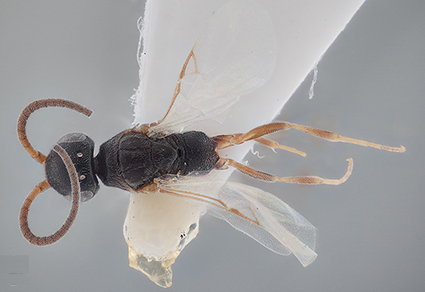Abstract
The female and male of Sclerogibba berlandi Benoit, 1963 (Hymenoptera: Sclerogibbidae), collected in Abu Dhabi (United Arab Emirates) and characterized by a pronounced sexual dimorphism, were associated for the first time by mitochondrial COI sequences. A comparison with COI sequences of S. crassifemorata Riggio & De Stefani-Perez, 1888 and S. talpiformis Benoit, 1950 from Abu Dhabi proved the diversity of S. berlandi. The COI sequence of a female of S. rossi Olmi, 2005 from Japan, Okinawa-jima, was analyzed for the first time and compared with the other sequences.
References
Ashmead, W.H. (1902) Classification of the fossorial, predaceous and parasitic wasps, or the superfamily Vespoidea. The Canadian Entomologist, 34, 287–291. https://doi.org/10.4039/Ent34287-11
Benoit, P.L.G. (1950) Les Sclerogibbidae (Hym.-Acul.) éthiopiens. Revue de Zoologie et de Botanique Africaines, 44 (1), 132–134.
Benoit, P.L.G. (1963) Bethylides nord-africains recoltès par M.L. Berland. Bulletin du Muséum national d’histoire naturelle, 2° Série, 35, 82–84.
Corley, M.F.V. & Ferreira, S. (2017) DNA barcoding reveals sexual dimorphism in Isotrias penedana Trematerra , 2013 (Lepidoptera: Tortricidae, Chlidanotinae). Zootaxa, 4221 (5), 594–600. https://doi.org/10.11646/zootaxa.4221.5.7
Folmer, O., Black, M., Hoeh, W., Lutz, R. & Vrigenhoek, R. (1994) DNA primers for amplification of mitochondrial cytochrome c oxidase subunit I from diverse metazoan invertebrates. Molecular Marine Biology and Biotechnology, 3, 294–299.
Gariepy, T.D., Bruin, A., Konopka, J., Scott-Dupree, C., Fraser, M.-C. & Talamas, E. (2019) A modified DNA barcode approach to define trophic interactions between native and exotic pentatomids and their parasitoids. Molecular Ecology, 28 (2), 456–470. https://doi.org/10.1111/mec.14868
González-Vaquero, R. A., Roig-Alsina, A. & Packer, L. (2016). DNA barcoding as a useful tool in the systematic study of wild bees of the tribe Augochlorini (Hymenoptera: Halictidae). Genome, 59 (10), 889–898. https://doi.org/10.1139/gen-2016-0006
Kimura, M. (1980) A simple method for estimating evolutionary rates of base substitutions through comparative studies of nucleotide sequences. Journal of Molecular Evolution, 16, 111–120. https://doi.org/10.1007/BF01731581
Kumar, S., Stecher, G. & Tamura, K. (2016) MEGA7: Molecular Evolutionary Genetics Analysis version 7.0 for bigger datasets. Molecular Biology and Evolution, 33, 1870–1874. https://doi.org/10.1093/molbev/msw054
Mita, T. & Olmi, M. (2018) Taxonomic additions of Embolemidae and Sclerogibbidae (Hymenoptera: Chrysidoidea) from Japan, with description of a new species of Trogloembolemus. Zootaxa, 4497 (4), 586–592. https://doi.org/10.11646/zootaxa.4497.4.8
Olmi, M. (2005 [2003–2004]) A revision of the world Sclerogibbidae (Hymenoptera Chrysidoidea). Frustula entomologica, New Series, 26–27, 46–193.
Olmi, M. (2008) Order Hymenoptera, family Sclerogibbidae. In: Van Harten, A. (Ed.). Arthropod fauna of the UAE. Vol. 1. Dar Al Ummah Printing, Abu Dhabi, pp. 372–374.
Olmi, M. (2014) Order Hymenoptera, families Dryinidae and Sclerogibbidae. New records from the United Arab Emirates. In: Van Harten, A. (Ed.), Arthropod fauna of the UAE. Vol. 5. Dar Al Ummah Printing, Abu Dhabi, pp. 334–340.
Olmi, M. (2020) Biodiversity of the aculeate wasps (Hymenoptera: Aculeata) of the Arabian Peninsula: Chrysidoidea, Sclerogibbidae. In: Gadallah, N.S., Brothers, D.J. & Williams, K.A. (Eds.). Biodiversity of the aculeate wasps (Hymenoptera: Aculeata) of the Arabian Peninsula. Zootaxa, 4754 (1), 131–133. https://doi.org/10.11646/zootaxa.4754.1.13
Okajima, G. (1926) Description of a new species of Oligotoma from Japan together with some notes on the family Oligotomidae (Embiidina). Journal of the College of Agriculture, Imperial University of Tokyo, 7 (4), 411–432.
Perkovsky, E.E., Martynova, K.V., Mita, T., Olmi, M., Zheng, Y., Müller, P., Zhang, Q., Gantier, F. & Perrichot, V. (2020) A golden age for ectoparasitoids of Embiodea: Cretaceous Sclerogibbidae (Hymenoptera, Chrysidoidea) from Kachin (Myanmar), Charentes (France) and Choshi (Japan) ambers. Gondwana Research, 87, 1–22. https://doi.org/10.1016/j.gr.2020.06.004
Richards, O.W. (1939) The Bethylidae subfamily Sclerogibbinae (Hymenoptera). Proceedings of the Royal Entomological Society of London (B), 8, 211–223. https://doi.org/10.1111/j.1365-3113.1939.tb00481.x
Richards, O.W. (1958) Records of Indian Sclerogibbinae (Hymenoptera: Bethylidae). Annals and Magazine of Natural History, 13, 17–18. https://doi.org/10.1080/00222935808651138
Riggio, G. & De Stefani-Perez, T. (1888) Sopra alcuni Imenotteri dell’Isola di Ustica. Naturalista Siciliano, 7, 145–150.
Ross, E.S. (2000) Embia. Contributions to the biosystematics of the insect order Embiidina. Part 1. Origin, relationships and integumental anatomy of the insect order Embiidina. Occasional Papers of the California Academy of Sciences, 149, 1–53.
Shinohara, A. & Yamasako, J. (2020) Hyperxiphia hirashimai, comb. n.(Hymenoptera, Xiphydriidae) from southern Japan: remarkable sexual dimorphism revealed by DNA barcodes and new distribution records. Zootaxa, 4822 (3), 4822. https://doi.org/10.11646/zootaxa.4822.3.5
Tribull, C. (2015) Phylogenetic relationships among the subfamilies of Dryinidae (Hymenoptera, Chrysidoidea) as reconstructed by molecular sequencing. Journal of Hymenoptera Research, 45, 15–29. https://doi.org/10.3897/JHR.45.5010
Yasumatsu, K. (1958) A new addition to the genera of the Sclerogibbidae (Hymenoptera). Kontyû, 26, 20–24.
Zhai, Q., Xue, G.-X. & Li, M. (2017) DNA barcoding-based sexual association of Sovia lucasii and S. lii (Lepidoptera: Hesperiidae), with description of a new subspecies. PLoS ONE, 12, e0183847. https://doi.org/10.1371/journal.pone.0183847


